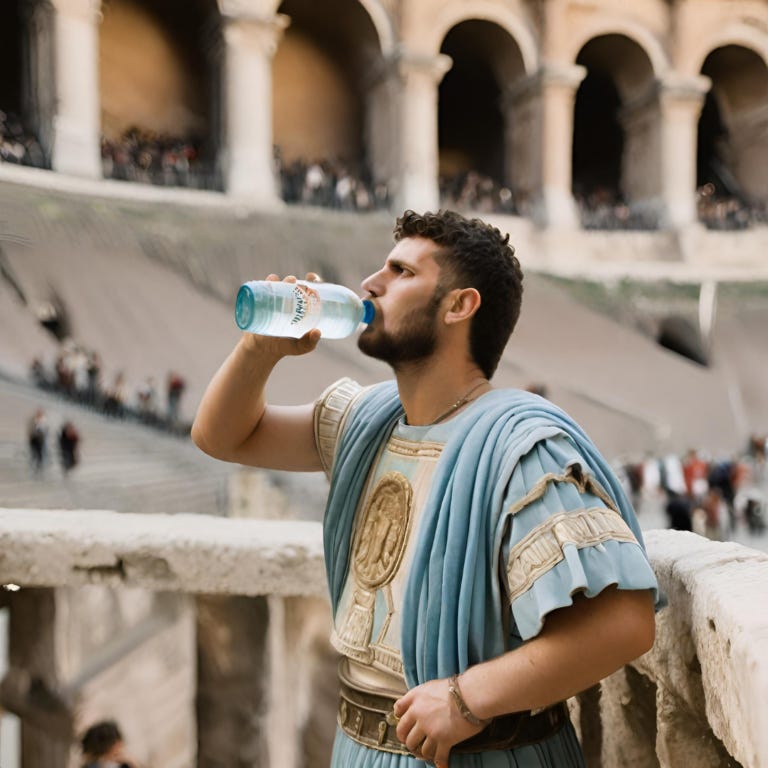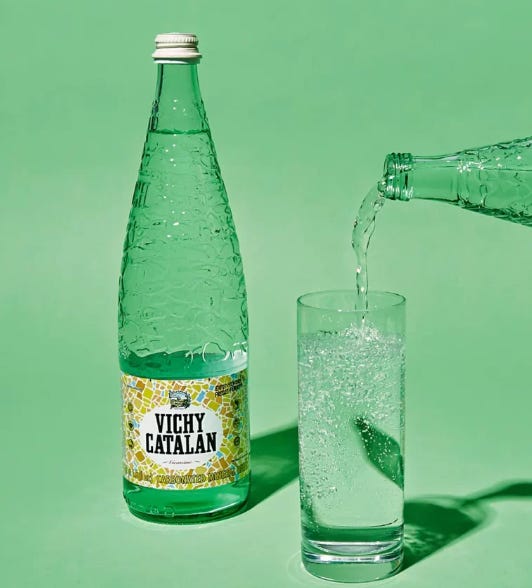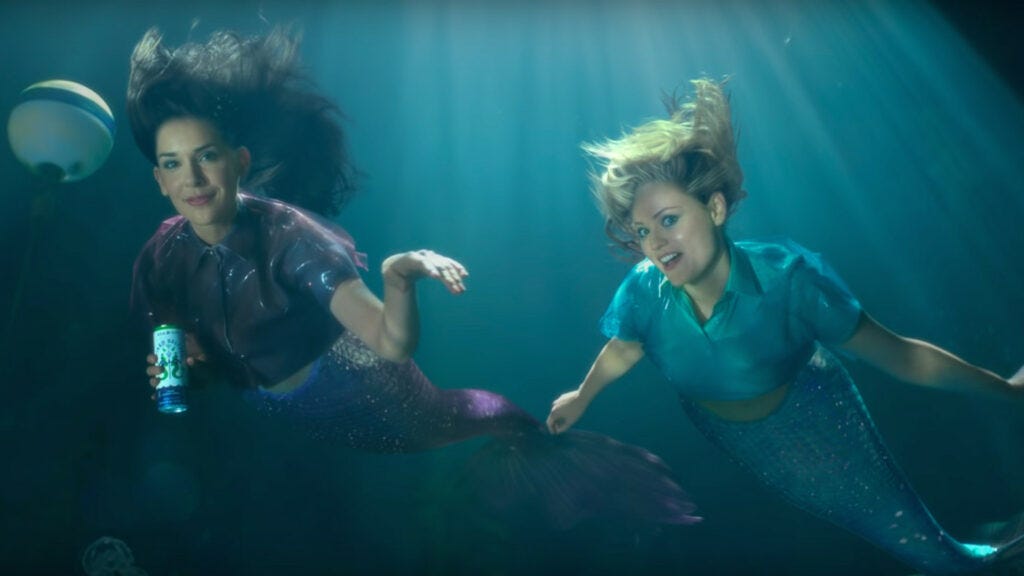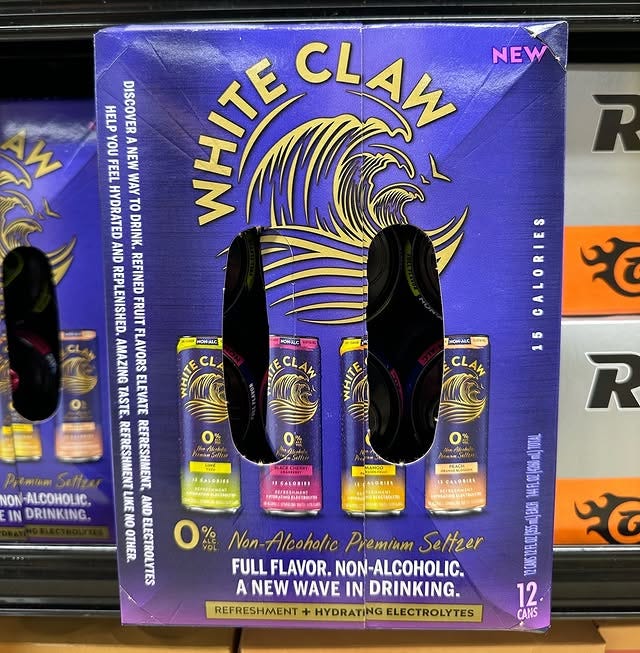what does White Claw have to do with The Romans?
a history of bubbly water
I drink bubbles in my water. They make a cool glass of water that much more crisp, clean and light. I love pouring my loaded Sodastream canister over a cocktail, and really found love making cimarronas part of my daily liquid rotation in the summer. The whole alcoholic fizzy water phase came about when I was doing my Masters abroad, and I was so confused seeing White Claw, Truly, and others, as a main staple of the Fourth of July holiday. Europe was still in this craft beer phase that had enraptured the early 2000’s of the US and had turned its sights more to the no-low movement. Anyway, I’m meandering through the past. What really made me want to dig into effervescent water was seeing that White Claw has reversed course and now sells NA hard seltzer (I think I’ll stick to Bawi instead, dog). Why do so many folks dig these unstill beverages, and are they good for you?
I tried (and failed) not to use the term seltzer, club soda, bubbly water, fizzy water, carbonated water or sparkling water. I’m talking today about your La Croix(e?)s, your San Pelligrinos and your Gerolsteiners. Each one of these terms can be a bubbly beaut depending on where in the US you are or are from. Growing up in the Midwest, we would normally call it club soda (especially if it were out of the soda gun) or carbonated water (if it came in a bottle). Most of the East Coast would refer to this as seltzer and I have to admit, between the hard seltzer craze and also getting the Midwestern “pop” kicked out of my vocabulary, I now call it seltzer. So I’ll be referring to water with gas generally as seltzer, but it’s important to read on and see where those names come from.
they just wanted to bathe Tornbern…
Seltzer derives its name from a German town, Selters, with naturally sparkling mineral water. This water was sought out to bathe in and drink (hopefully not at the same time) since the Roman age for its healing powers, but couldn’t be transported outside of this Northern German town. Even the town name comes from a Latin for aqua saltare, or, jumping water. The word “selters” became a common nod to effervescent water throughout Europe, which made the German and English speaking world primed to further butcher the Latin in the late 1700’s when Tornbern Bergman found out how to make artificial “selters water”. He learned that if you add an acid and a base in solution you get water and carbon dioxide, and that when containing the gas in a closed bottle during the reaction, you would create carbonated water. Now imagine you live in the unsanitary conditions of Paris in 1800 and your homie Francois at the bodega around the block got a plug to this new bottled selters waters. This health potion caught on like wildfire at this time like people’s use of social media in the early naughts. Don’t worry about any more etymology because most people still don’t care about the mineral content, and just associate bubbly water with their term, or brand (how you doin’ Vichy Catalan) of choice.
In 1810, two gentlemen from South Carolina patented making what they began to call “soda water” in metal chambers. They began to sell these chambers of soda water to drug stores so Americans could get their fix of Selters’ best. This dovetailed nicely with a string of panacea salesmen peddling “nerve tonics” and other tonics to cure all ailments. Not much more than fifty years later did we get Dr. Pemberton combining coca leaf and kola nut in Atlanta. This doctor sold his elixirs to drug stores to be consumed at the counter for folks looking to cure their headaches and nerves with a sweet cocaine- and caffeine-laden wine treacle, Pemberton’s French Wine Coca…er…Coca Cola. And what’s better than one healthful elixir? Combining it with another one. Soda counters in the late 1900’s combined the life-giving effects of soda water with the wildly unhinged soda syrup to produce Coca-Cola throughout Georgia and beyond (read how in my last post). These drug stores slowly turned into “soda fountains” which is why most restaurants still call their cup for a Freestyle machine a “fountain drink” – they combine syrups and soda water without the pesky gaze of a soda jerker. These institutions dried up in the 1960’s but CVS and Walgreens haven’t slowed down selling you any of the tonics you crave.
so when did we start putting booze in fizzy water?
In 2013, Bon & Viv did the unthinkable and created spiked seltzer by “combining disciplines of brewing, winemaking, and natural flavors.” Essentially they made light malt liquor with some flavors from one of the big flavor houses and were off to the races.
What started as a fad began to climb the ladder of popularity when White Claw released in 2016 and seemingly became omnipresent from that point on. The rebrand of what was essentially Colt 45 to a younger demographic that gave a whopper of a hangover was so strange to me. How did we go from the life-giving waters of Selters to Mango White Claw bros? Would Tornbern be happy with the weapon he had given precedent to?
where do we go from here?
A few weeks back I saw this post while at my local dive:
I didn’t know what to do but chuckle to myself by a pool table and show Fiona. There’s no question that the NA space has been growing since after the pandemic began to subside because folks either dug deeper into their penchant for a drink or sought alternatives to getting drunk alone in their 500 square foot apartment. Even the soda space is popping off with drinks like Olipop and Poppi, with their less sweet and potential added benefits. What’s interesting about White Claw Zero is that it’s regressing to being a soda, but not giving you any of the feel good aspects of a soda alternative. I don’t know that I’m ever going to take a road trip with one of these sugary soda waters in my cup holder just because it reminds me of summer nights around a campfire. The brand association isn’t there and honestly I would want someone to ask if I’m alright if I had a fridge full of these poppers. No judgment though.
Seltzer has been a go-to drink for many in the Americas and Europe for centuries now and it has taken many different forms. I, for one, see my SodaStream as a lifeline and I was glad to see health officials tell me it’s just as hydrating as normal water and won’t mess up my teeth or stomach. The only downside to it can be the sodium content, but you really gotta be putting bottles away (or pounding cimarronas – shout out once again). I look forward to the new types of effervescent elixirs my friends in the beverage industry continue to cook up, and here’s to hoping it’s not a repackaged version of Liquid Death.





